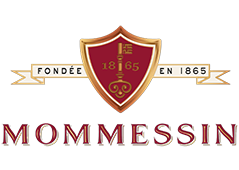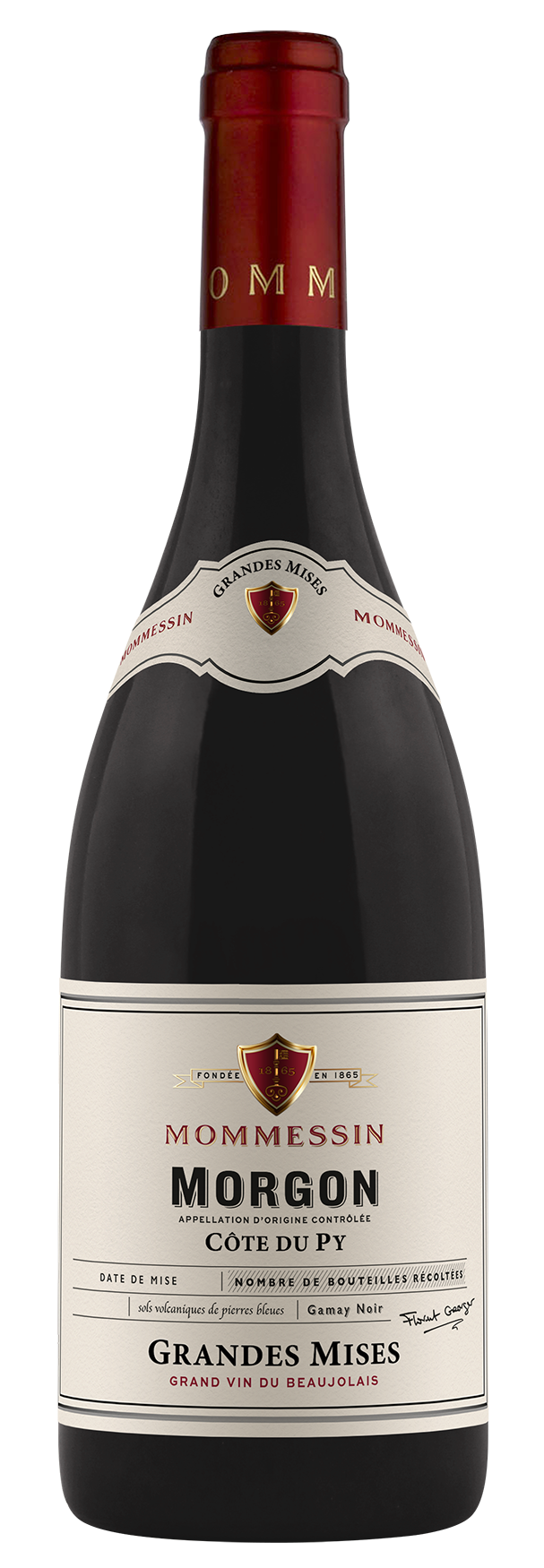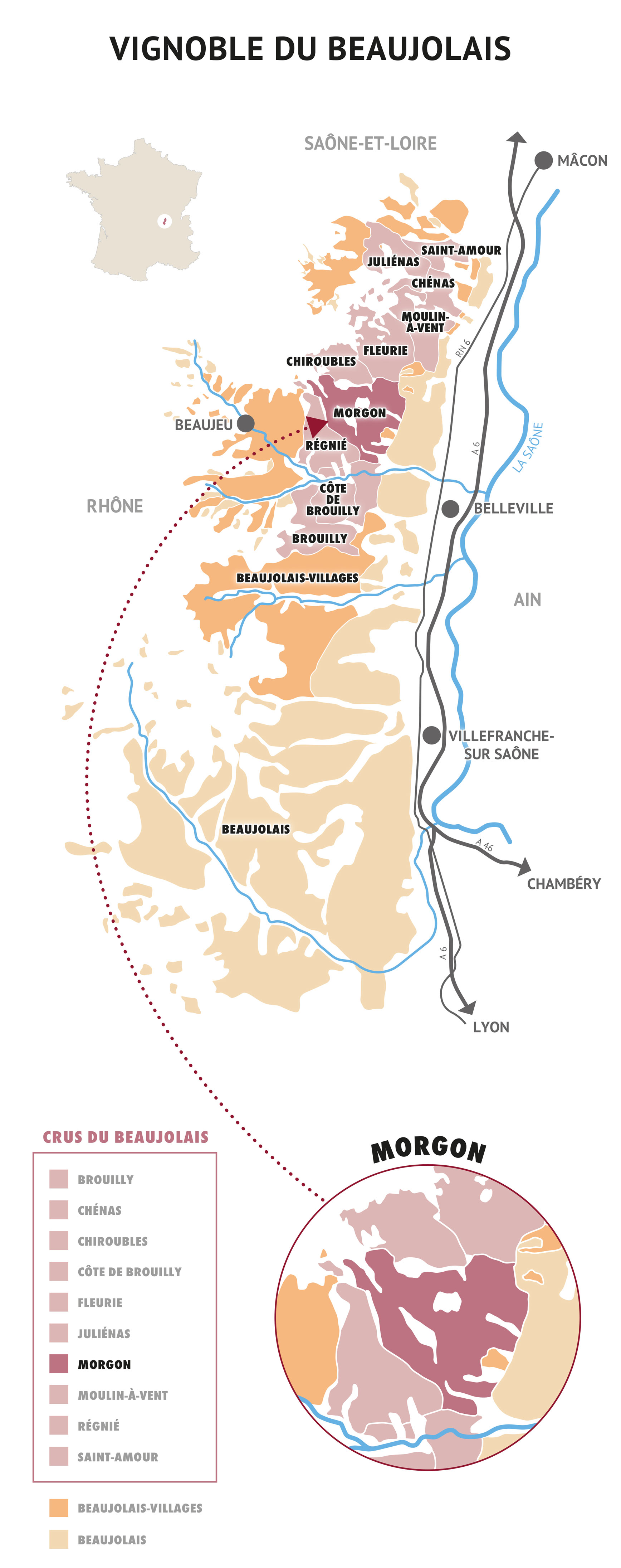Grape varietal
Black Gamay with white juice.
Tasting notes
This Morgon Côte du Py shows a deep red-ruby robe and a elegant nose of black cherry, iris flower and spices.
In the mouth, it offers a great pure minerality with dense and velvety tannins, elegant with a long aromatic persistency.
Serving suggestions
Best served at a temparatur of about 15°C to 18°C. (59-64°F.)
Food and wine pairing
Morgon « Côte du Py » pairs well with duck and feathered game dishes. It would also match with rippened cheeses full of character.
Let be amazed by decanting this astonishing wine!
Ageing potential
Morgon « Côte de Py » has a tremendous ageing potential: This well-balanced wine can age up to 10 years, with correct temperature and humidity conditions.
Origins
From the 10th Century onwards, we find traces of vineyards in Morgon. An act dated 956 A.D.shows the sale of a vineyard by the Sire de Beaujeu to a local vassal. Morgon is one of the 10 crus of the Beaujolais. The vineyard is situated on hills west of the Saône river, in the heart of the crus in the northern part of the region. (50 Km north of Lyon, 25 km north of Villefranche and 25 km south of Mâcon) and stretches over 1,100 hectares.
Terroir
A special terroir made up of decomposed rocks and brittle schists, Morgon is split between 6 distinct climats - Les Micouds, Corcelette, Douby, Les Grands Cras, Les Charmes and the most famous “Côte du Py”.
Formed by the weathering of brittle crystalline rocks, essentially pyritic schists, rich in iron-oxide and a little manganese, the soil is made up by irregular-shaped rocks, thus containing more or less clay. What is known as “roche pourrie” or “morgon” is a very-advanced form of schists and very old volcanic rocks. The Py hillside, which culminates at 352 metres gives the best terroirs with fine layers of volcanic, schistous rocks rich in manganese and iron.
Vine and soil
Soil: very deep and drains easily, ideal conditions for the Gamay grape whatever the weather
Vineyard age: between 35 and 45 years old.
Yield: 56 hectoliters per hectar
3 hectars divided in 4 plots have been selected with the partner-grower.
Oriented south and south-west with a slope often greater than 30%.
The vines are pruned « en gobelet » and « en cordon-de-Royat ». They are managed with substainable farming methods
Vinification and maturing
Harvest took place on the "Côte du Py" parcels, on September 2020, the 3rd. The grapes were collected by our partner-growers.
Burgundy-style vinification: 80% of the grapes have been destemmed. Then, the harvest has been placed in a concrete vat by gravity. The maceration lasted 18 days with cap-punching, over-pumping and racking before the pressing.
A plot selection has been realized, and each cuvee is vinified separately. 20% of the wine is aged in 228-litre oak Burgundy barrels of French origin, mainly from the Troncais forest undergo a medium « firing », to give a light toasted style, with sweetness and roudness.
The wine has then been aged for 8 months on fine lees.
Bottled in June 2021.
28 860 bottles produced.
Vintage : 2020
Gorgeous colors and mouth-filling wines
Winter 2019-2020 was the warmest in France since the beginning of the 20th century. There was no hard frost at all. The average temperatures in the Beaujolais region over the first four months of the year were the mildest since 1947!
Very fine grapes that are extremely aromatic. The quantity of the harvest has varied from appellation to appellation and terroir to terroir. Intense colour and good acidity.
The harvests:
18th August: the harvest begins with the Côte de Brouilly (21 days ahead of 2019!)
20th August: Beaujolais-Villages.
28th August: the whole Beaujolais region is hard at work.
19th September: the harvest finishes.
This year has been marked by tremendous diversity between different plots, these having reacted differently to the extreme weather conditions (lack of rain over much of the year and hot conditions). Some plots have lost a lot of juice, others have coped marvellously well! Several factors account for these differences: the soil, siting and exposure to sunlight, age, the yield of individual vines etc…
As a result, key variables are different from one wine to another. Potential alcohol fluctuates between 12° and 15°. The Gamays have good aromatic potential with a thick epicuticular wax layer (bloom).
This year we have favoured destemming with long maceration periods to really bring out the elegance of this vintage. Obviously, the traditional semi-carbonic maceration approach used in tandem with vendange entière is still called for to draw out our Gamay’s aromatic subtlety, not to mention hot pre-fermentative maceration to extract as much colour as possible from the grapes that were most affected by drought.
Initial tastings, Lydie Nesme:
‘It’s a journey through the senses that’s intense and complex, a real pleasure for the taste buds, with aromas of raspberry, cherry, morello cherry and even pear! It’s a real delight to test the must with all the gorgeous colours it exhibits!
Our Beaujolais’ aromatic palette is a broad one, ranging from raspberry liqueur, ripe Burlat cherries in syrup, smooth crème de cassis and wild blueberry to floral notes of violet, iris and peony, liquorice and dark chocolate. Mouth-filling despite high levels of acidity in some cases. The wines are supple, round and smooth, well-structured with supple, silky tannins. An elegant vintage in the making.’




